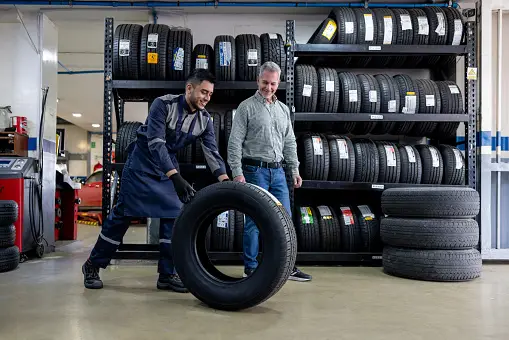November 5, 2023
Does it matter if all your tires are the same?
Yes, it does matter if all your tires are the same, especially in terms of safety, performance, and handling of your vehicle. Here are some reasons why it’s important to have matching tires:
- Handling and Stability: When all four tires are the same make, model, and size, they provide consistent traction and handling characteristics. This helps ensure that your vehicle behaves predictably when you steer, brake, or accelerate, which is crucial for safe driving.
- Balanced Performance: Different tires can have varying levels of grip, tread patterns, and rubber compounds. Mismatched tires can lead to uneven performance, potentially causing your vehicle to handle poorly in certain situations, especially in adverse weather conditions like rain or snow.
- Traction and Braking: Matching tires help maintain consistent traction and braking performance. If you have different types of tires on your vehicle, it may take longer to stop or struggle to maintain grip during cornering or sudden maneuvers.
- Wear and Tear: Tires wear out over time, and having matching tires makes it easier to rotate them regularly to ensure even wear. Mismatched tires may wear unevenly, which can decrease their lifespan and require more frequent replacement.
- All-Wheel Drive and Four-Wheel Drive Systems: Many all-wheel drive (AWD) and four-wheel drive (4WD) systems are designed to work optimally with matching tires on all four wheels. Mismatched tires can cause strain on these systems and potentially lead to damage.
- Comfort and Ride Quality: Matching tires contribute to a smoother and more comfortable ride. Mismatched tires can lead to vibrations and unevenness in the vehicle’s ride quality.
- Warranty and Liability: Some vehicle manufacturers and tire warranties may stipulate that all four tires should be of the same type, size, and specifications. Using mismatched tires could void warranties and create liability issues in case of accidents.
In summary, it’s generally recommended to have all your tires be the same in terms of make, model, size, and tread pattern to ensure safety, performance, and longevity. When you need to replace one or more tires, it’s a good practice to replace them in sets of two or all four to maintain consistent handling characteristics and safety. Always refer to your vehicle’s owner’s manual and consult with a tire professional for guidance on selecting the right tires for your specific vehicle and driving needs.
How often should tires be replaced?
The frequency at which tires should be replaced depends on several factors, including the type of tire, driving habits, road conditions, and tire maintenance. Here are some general guidelines to help you determine when to replace your tires:
- Tread Depth: Tires have built-in tread wear indicators (usually in the form of small raised bars) that become visible as the tire tread wears down. When these indicators are flush with the tread surface, it’s a sign that the tire has reached its minimum legal tread depth, which is typically 2/32 of an inch (about 1.6 millimeters). However, for safety reasons, many experts recommend replacing tires when the tread depth reaches 4/32 of an inch or even earlier for better traction, especially in wet or snowy conditions.
- Age: Regardless of tread wear, tires also have a maximum recommended service life due to the natural aging of the rubber. Many tire manufacturers recommend replacing tires that are six to ten years old, even if they appear to have sufficient tread depth and haven’t been used much. You can find the manufacturing date on the tire sidewall as a four-digit code. The first two digits represent the week, and the last two digits represent the year of manufacture.
- Visual Inspection: Regularly inspect your tires for signs of damage, such as cuts, bulges, cracks, or punctures. If you notice any of these issues, it’s advisable to replace the affected tire(s) promptly.
- Driving Habits and Conditions: Frequent and aggressive driving, as well as exposure to harsh road conditions like rough terrain, potholes, or extreme temperatures, can accelerate tire wear. In such cases, tires may need replacement sooner than those used under more moderate conditions.
- Rotation and Maintenance: Regular tire maintenance, including tire rotations, wheel alignments, and proper tire inflation, can help extend the lifespan of your tires. Follow the manufacturer’s recommendations for maintenance intervals in your vehicle’s owner’s manual.
- Performance and Handling: As tires age and wear, they may gradually lose their grip and performance, affecting your vehicle’s handling and safety. If you notice a significant decline in performance or an increase in road noise, it may be time to replace your tires.
It’s important to keep in mind that different types of tires (e.g., summer, all-season, winter) have different lifespans and performance characteristics. Additionally, local regulations and safety standards may vary, so it’s a good idea to check with local authorities or consult your vehicle’s owner’s manual for specific recommendations on tire replacement intervals.
Regularly monitoring your tires’ condition, maintaining proper tire inflation, and following the manufacturer’s guidelines for tire replacement will help ensure your safety on the road and maximize the lifespan of your tires. When in doubt, consult with a tire professional for a thorough evaluation of your tires’ condition and for personalized recommendations.

